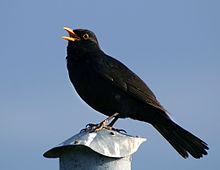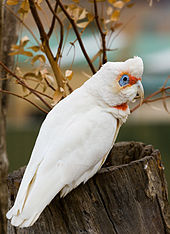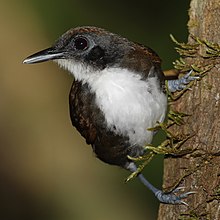Wikipedia:Wikipedia Signpost/2009-05-11/Dispatches
WikiProject Birds reaches an FA milestone
Birds are popular subjects for writers, artists, photographers and scientists. They are important in religion and culture, popular as pets and on the dinner table, and millions count birdwatching as a hobby. It is no surprise that they are also popular subjects of articles on Wikipedia, with an active Birds Wikiproject that assists editors in improving these articles. The project page hosts frequent debates on Wikipedia conventions especially on the article name capitalization convention.[1]

Challenges
Future challenges include high-traffic articles[2] such as Penguin, Parrot and Cockatoo. Several of WP Birds' most visited pages are in need of a considerable amount of work to get them to featured status. Interestingly, most bird-related articles rely on primary references especially from peer-reviewed journals. Secondary references such as family monographs or specialized group guides are often either outdated or expensive[3] and hard to find. The project has debated the sourcing guidelines of Wikipedia, and has noted that some secondary references can be unreliable.[4]
There are dilemmas in some high-traffic articles where common-names do not match classification. For example, the high traffic duck overlaps in scope with the much-less visited duck family article, Anatidae, as it includes geese and swans as well. This has led to some debate on how to proceed, and brings up issues on WikiProject Birds' purpose and a need to reflect on folk taxonomy versus biological classification.[5]
Systematic bias

Another issue with writing bird articles is one of countering systematic bias. In bird-related articles this manifests in several ways: a bias towards taxon articles and a neglect of conceptual articles relating to ecology and behaviour (such as bird migration, bird vocalization etc.); within the taxon articles there is a bias towards species with higher level taxa (family and order) articles left underdeveloped. The best species articles themselves tend to be those that are found in the English speaking and developed countries. Of the first 50 featured articles on birds, over 40 are about individual species, whereas just 5 are about families (and one is both a species and family). Only two species articles and a family article deal exclusively with South American birds, and there are no articles for families unique to Africa or Asia. Many of the species covered have wide ranges that may include these under-represented parts of the world, but importantly, they are also found in Europe, North America or Australia and New Zealand.

There are good explanations for this bias. While articles about families, genera, orders and even generalised types of birds are more important than individual species articles, they are also much harder to write. Sources are difficult to find, and information from numerous sources needs to be combined to make general statements about the higher level taxa while avoiding original research by synthesis. This is particularly problematic when some species of a family or group are found in the less-developed parts of the world where published studies can be lacking or hard to find. Editors may find themselves typing "birds in the family x all do y, except for a,b and c, which do z" and "some frigatebirds do this" and "most bango-birds sound like bangos" over and over. Species, on the other hand, tend to be more conducive to sweeping statements like "Lesser Bango-birds live in Armenia and eat frogs and sound like a bango". The problem with conceptual articles with a wide scope (such as birdwatching, ornithology, bird migration) is similar but additionally lack an established structure that multiple authors can accept and follow. These articles need to cover not just facts, but also historical, methodological and philosophical aspects.[6][7]
Regional bias is even more difficult to combat, due to the underlying imbalance in research. There are more ornithological studies in the developed world.[8] In the less-developed world, funds for bird research typically focus on rare species. For example searching for the Common Blackbird (Turdus merula), a common European species and featured article, on the Web of Science results in 406 citations, whereas the Andean Slaty Thrush (Turdus nigriceps), a South American species of the same genus covered by a stub article, has just one paper published on it. It is hardly possible to generate a featured article for a species that only one study has ever been published about.

Help with writing articles on birds
Wikiproject Birds maintains a collection of resources to help editors write good bird articles (and hopefully Featured ones). Most important of these is the accumulated collection of references that are reliable, online and free. Many important journals have made older issues available to all and these form an invaluable resource when writing reliably about birds. At WT:BIRD you'll also find additional help, and regular challenges in the form of bird identification requests. And finally, there is an informal guide to writing about birds, written especially to aid school and university projects.
References
- ^ A debate on capitals in bird names
- ^ Most visited bird pages
- ^ Handbook of the Birds of the World purchase plan
- ^ A discussion on primary sources
- ^ Duck merger discussions
- ^ Farber, Paul L. (1982). The Emergence of Ornithology as a Scientific Discipline, 1760-1850. D. Reidel Publishing Company, Boston.
- ^ Streseman, Erwin (1975) Ornithology: From Aristotle to the present. London.
- ^ Duffy, David Cameron (1988) Ornithology in Central and South America: Cause for Optimism? The Auk 105(2):395–396 PDF


Discuss this story